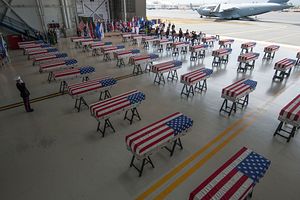The remains of a U.S. soldier believed to have been captured by Chinese forces in North Korea in December 1950 and who later died in a prisoner-of-war camp have been identified, officials said Thursday.
The soldier, Sgt. Frank Julius Suliman, is the third American servicemember to be identified from among 55 boxes of bones and other material that the North Korean government handed over to the United States last summer. Efforts to identify them are led by a Defense Department laboratory in Hawaii.
Suliman, a member of the headquarters and headquarters company of the 9th Infantry Regiment, 2nd Infantry Division, was from Nixon, New Jersey, and was 20 years old when he died in the POW camp, according to Charles Prichard, spokesman for the Defense POW-MIA Accounting Agency. Further details about his background were not immediately available. Suliman’s remains were identified on January 15.
The return of unspecified numbers of Korean War remains was among commitments made by North Korean leader Kim Jong Un during his summit meeting in Singapore with President Donald Trump in June 2018. Kim also agreed to “work toward” denuclearization of the Korean Peninsula, but efforts to move that deal toward an elimination of the North’s nuclear weapons have been stalled. A follow-up summit is expected to be held next month.
Although the Pentagon wants to make arrangements to recover additional U.S. battlefield remains from North Korea this year, the North Koreans thus far have been unwilling to agree to face-to-face negotiations.
By the Pentagon’s account, Suliman was captured by Chinese forces on December 1, 1950. He had been riding in a vehicle convoy when it was halted by a roadblock south of Kunu-ri, North Korea. Fellow soldiers later reported that Suliman was captured after they abandoned their vehicles to proceed on foot.
Hundreds of thousands of Chinese soldiers entered the Korean War on North Korea’s behalf in the fall of 1950 after U.S. forces gained the upper hand with the Inchon landing in September. The Chinese pushed the Americans and their South Korean allies south; thousands were buried in shallow battlefield graves or perished in POW camps.
By the Pentagon’s account, Suliman was taken to a Chinese-run camp at Pukchin-Tarigol in northern North Korea, and he died there in March 1951. The camp was in a narrow valley that the Americans called “Death Valley.” Soldiers who survived captivity there recalled harsh conditions, with little food and rampant disease.
The Pentagon says the remains of 350 Americans may be at the “Death Valley” camp. In all, the Pentagon believes the remains of more than 5,000 U.S. servicemen who perished in North Korea could be recovered.
The Pentagon says it has not yet determined how many U.S. servicemen may be identified from the remains in the 55 boxes returned by North Korea last August. The transfer of the 55 boxes was the first mass turnover of remains by North Korea since the 1990s. Prior to Suliman, only two had been positively identified. They are Army Master Sgt. Charles H. McDaniel, of Butler, Missouri, and Vernon, Indiana, and Army Pfc. William H. Jones, of Nash County, North Carolina.
By AP National Security Writer Robert Burns with additional reporting by The Diplomat.

































